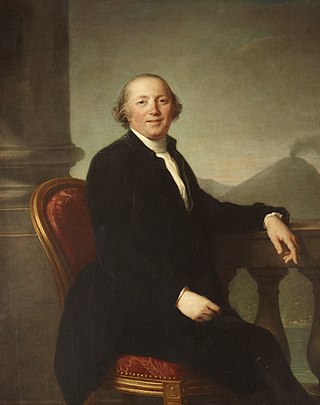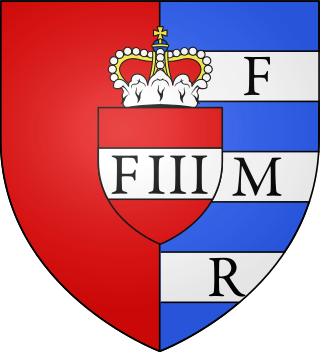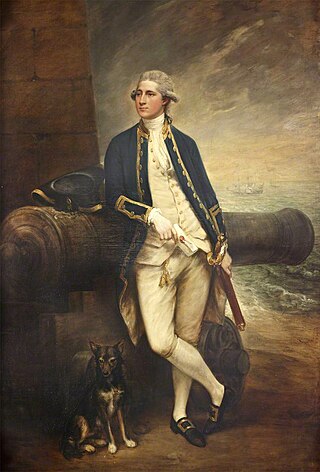
Marquess of Bristol is a title in the Peerage of the United Kingdom held by the Hervey family since 1826. The Marquess's subsidiary titles are Earl of Bristol, Earl Jermyn, of Horningsheath in the County of Suffolk (1826), and Baron Hervey, of Ickworth in the County of Suffolk (1703). The Hervey barony is in the Peerage of England, the earldom of Bristol in the Peerage of Great Britain and the Jermyn earldom in the Peerage of the United Kingdom. Earl Jermyn is used as courtesy title by the Marquess's eldest son and heir. The Marquess of Bristol also holds the office of Hereditary High Steward of the Liberty of St Edmund. The present holder of these titles is Frederick Hervey, the 8th Marquess and 12th Earl of Bristol.

Frederick Augustus Hervey, 4th Earl of Bristol,, was an 18th-century Anglican prelate.

Earl of Suffolk is a title which has been created four times in the Peerage of England. The first creation, in tandem with the creation of the title of Earl of Norfolk, came before 1069 in favour of Ralph the Staller; but the title was forfeited by his heir, Ralph de Guader, in 1074. The second creation came in 1337 in favour of Robert de Ufford; the title became extinct on the death of his son, the second Earl, in 1382. The third creation came in 1385 in favour of Michael de la Pole. The fourth creation was in 1603 for Lord Thomas Howard, the second son of Thomas Howard, 4th Duke of Norfolk, by his second wife Margaret Audley, the daughter and eventual sole heiress of Thomas Audley, 1st Baron Audley of Walden, of Audley End in the parish of Saffron Walden in Essex. Howard was a prominent naval commander and politician and served as Earl Marshal, as Lord Chamberlain of the Household and as Lord High Treasurer. In 1597 he was summoned to Parliament as Baron Howard de Walden, and in 1603 he was further honoured, at the start of the reign of King James I, when he was created Earl of Suffolk. His second son the Hon. Thomas Howard was created Earl of Berkshire in 1626.

Earl of Carlisle is a title that has been created three times in the Peerage of England.

Baron de Clifford is a title in the Peerage of England. It was created in 1299 for Robert de Clifford (c.1274–1314), feudal baron of Clifford in Herefordshire, feudal baron of Skipton in Yorkshire and feudal baron of Appleby in Westmoreland. The title was created by writ, which means that it can descend through both male and female lines. The Norman family which later took the name de Clifford settled in England after the Norman Conquest of 1066 and was first seated in England at Clifford Castle in Herefordshire. The first Baron served as Earl Marshal of England but was killed at the Battle of Bannockburn in 1314. His 8th generation descendant the 11th Baron, was created Earl of Cumberland in 1525, whose grandson the 3rd Earl was a noted naval commander. On the latter's death in 1605, the earldom passed to his younger brother, the 4th Earl.

Baron Dacre is a title that has been created three times in the Peerage of England, each time by writ.

Baron Braybrooke, of Braybrooke in the County of Northampton, is a title in the Peerage of Great Britain. It was created in 1788 for John Griffin, 4th Baron Howard de Walden, with remainder to his kinsman Richard Neville-Aldworth. Lord Howard de Walden was the son of William Whitwell and Anne Griffin, daughter of James Griffin, 2nd Baron Griffin of Braybrooke, who was the son of Edward Griffin, 1st Baron Griffin of Braybrooke, and his wife Lady Essex Howard, eldest daughter of James Howard, 3rd Earl of Suffolk and 3rd Baron Howard de Walden.

Baron Howard de Walden is a title in the Peerage of England. It was created by writ of summons in 1597 by Queen Elizabeth I for Admiral Lord Thomas Howard, a younger son of Thomas Howard, 4th Duke of Norfolk, by his second wife, the Honourable Margaret Audley, daughter of Thomas Audley, 1st Baron Audley of Walden.
Baron Furnivall is an ancient title in the Peerage of England. It was originally created when Thomas de Furnivall was summoned to the Model Parliament on 24 June 1295 as Lord Furnivall. The barony eventually passed to Thomas Nevill, who had married the first baron's descendant Joan de Furnivall, and he was summoned to parliament in her right. Their daughter, Maud de Neville, married John Talbot, who was also summoned to parliament in her right. He was later created Earl of Shrewsbury. On the death of the seventh earl in 1616, the barony fell into abeyance. The abeyance was terminated naturally in favour of the earl's daughter Alethea Howard in 1651 and passed through her to the Dukes of Norfolk. On the death of the ninth Duke in 1777, the barony again fell into abeyance. In 1913 the abeyance was terminated again in favour of Mary Frances Katherine Petre, daughter of Bernard Petre, 14th Baron Petre. Through her father she was a great-great-great-granddaughter of the ninth Baron Petre and his first wife Anne Howard, niece of the ninth Duke of Norfolk, who became co-heir to the Barony on her uncle's death in 1777. On Lady Furnivall's death in 1968 the barony fell into abeyance for the third time.

Baron Hylton is a title that has been created twice, once in the Peerage of England and once in the Peerage of the United Kingdom. The first creation came in the Peerage of England 1295 when Robert Hylton was summoned to the Model Parliament as Lord Hylton by writ. His son, Alexander, was called to Parliament in 1332 and 1335, but no further summons were sent for his descendants. Therefore, the title has only been held de jure after the death of the second baron. Indeed, the last baron was Member of Parliament for Carlisle after "inheriting" the title, due to this anomaly. Despite this, the creation is deemed to have fallen into abeyance on the death of the eighteenth baron without male heirs in 1746.
Charles Augustus Ellis, 6th Baron Howard de Walden and 2nd Baron Seaford, was a British diplomat and politician.

Baron North, of Kirtling Tower in the County of Cambridge, is an abeyant title in the Peerage of England. Its most famous holder was Frederick North, 2nd Earl of Guilford, 8th Baron North, who served as Prime Minister of Great Britain from 1770 to 1782, a period which included most of the American Revolutionary War.

Captain John Augustus Hervey, Lord Hervey was a British diplomat.

Charles Rose Ellis, 1st Baron Seaford was a British politician, planter and peer.

Thomas Evelyn Scott-Ellis, 8th Baron Howard de Walden, 4th Baron Seaford was an English peer, landowner, writer and patron of the arts.
John Osmael Scott-Ellis, 9th Baron Howard de Walden, 5th Baron Seaford TD was a British peer, landowner, and a Thoroughbred racehorse owner/breeder.

Frederick George Ellis, 7th Baron Howard de Walden and 3rd Baron Seaford, was a British landowner and at one point "the wealthiest peer in England".
Henrietta Bentinck, Duchess of Portland was the wife of William Bentinck, 4th Duke of Portland.
George William Stafford-Jerningham, 8th Baron Stafford, known as Sir George William Jerningham, 7th Baronet from 1809 to 1824, was a British peer who, in 1824, successfully obtained a reversal of the attainder of the barony of Stafford.
Colin Drummond was a Scottish merchant and politician who lived in Quebec, Canada.














